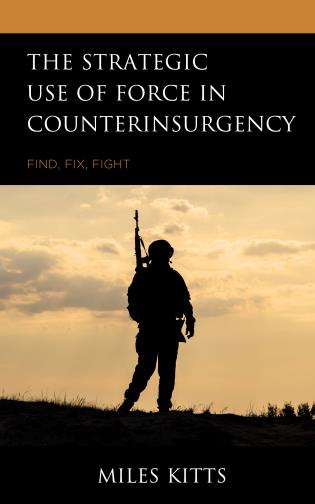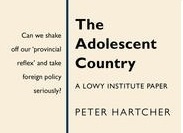Book Review: The Strategic Use of Force in Counterinsurgency: Find, Fix, Fight

Counterinsurgency has become a tool for interventions of one state to “rescue” another state from insurgency. In this book, Miles Kitts fuses two major conventional theories of counterinsurgency to create a new comprehensive approach that can inform future counterinsurgency actions.
Counterinsurgency has become a term coined with counterterrorism and conflicts in the Middle East. Despite the factors that come into play, the definition of counterinsurgency and the development of counterinsurgency practice have changed over the years as more scholar-practitioners became involved in the writing and understanding of what policies and strategies are best employed in counterinsurgency. In his book The Strategic Use of Force in Counterinsurgency: Find, Fix, Fight, Miles Kitts surveys this very aspect – what entails the use of force and how counterinsurgent success can be a vital requirement for the goals to be realised.
The book’s main aim is to examine how the use of force in the case of counterinsurgency is linked to the outcome. In other words, the book is situated at the heart of the debate in Security Studies between neo-classicism and revisionism. The first approach calls for action, while the second is reflective. It is from that perspective that Kitts put forward his new approach: “Reflective-Action.” This new approach combines the two theoretical debates and examines the approach by using three case studies to test it. This is an illustration of a new scholarly-practitioner exercise that the book is largely situated in.
The neoclassicism approach aims for victory and nothing less and the discourse surrounding the utility of force is perceived with no contextual and reflective strategy. On the other side of the spectrum, revisionism adopts a more contemporary outlook into insurgency tactics and strategy that counterinsurgency should reflect on the new (and evolving) nature of conflicts. These can be summarised into: the central hierarchical structure of insurgent groups, use of local support, and fighting in urban or rural areas. Moreover, Revisionists argue that, considering the current methods that insurgents employ, it thus becomes harder for counterinsurgents to achieve full victory as neo-classicists would argue. It is thus necessary and essential to use new strategies that do not necessarily echo Cold War-like strategies that neo-classist methods outlined accordingly. Hence, revisionism mirrors a reflective approach that builds on lessons learned from the past, employing new tactics that best fit the current scenario.
The literature surrounding insurgency provides a distinction between “classical” work on how to understand counterinsurgency and current understandings of the concept. By classical work, I am referring to the classical insurgency of the late colonial era, when insurgents were the initiators or revolutionaries who wanted to create a change. For insurgency as it is currently known, such as the cases of Afghanistan, Iraq, Pakistan, and Chechnya, insurgents are protecting the status quo or their regime from foreign invaders. While Kitts examines the literature based on the former (neo-classicism), he uses case studies that represent the latter. So instead of focusing on insurgents that want to change the regime, the book looks at insurgents who wanted to defend their regime from foreign invaders. The book examines the cases of British counterinsurgency during the Malayan emergency in 1948, American counterinsurgency during the Vietnam War in 1965, and the coalition counterinsurgency during the Iraq War in 2003.
The book is divided into two key parts: the first part offers a theoretical illustration and survey of the literature, while the second is much more methodological and focuses on testing the proposed reflective-action approach on the three case studies. What is interesting in Kitts’ method is that even though he employs a slight deviation from the literature by proposing a new combined approach, he nevertheless appropriates a prominent theoretical stand to assist his analysis. By this, I mean that Kitts used Galula’s counterinsurgency thesis and examination in order to support his quest in finding an appropriate and comprehensive approach for the utility of force. Galula’s work is pivotal in providing a set of principles for counterinsurgency from which some strategies can be derived. A brief summary would be that most of the rules that apply to one side do not necessarily apply to the other. Galula therefore hints at the ever-changing nature of conflict and insurgencies, and so should counterinsurgency.
Through the examination of the reflective-action approach in these three case studies, an important contribution to the literature of Security Studies presents itself. It is now acknowledged that counterinsurgency missions are no longer handled only by militaries. Rather, a more complex strategy is used that includes civilian agencies, non-governmental organisations, the media, regional actors, and most importantly, the “hearts and minds” of the local population. Kitson successfully summarises this by stating that “insurgents start with nothing but a cause and grow to strength, while the counterinsurgents start with everything but a cause and gradually decline in strength and grow to weakness.” This has proven pivotal and successful in the three cases that Kitts examined. For example, counterinsurgency transformed after the phrase “hearts and minds” was initially put forward by High Commissioner Gerald Templer during the Malayan emergency. This probably would not have been the case in the Cold War counterinsurgency approach, which was heavily focused on sometimes unattainable victory.
The reflective-action approach provides a useful approach that answers to the debates surrounding neo-classicism and revisionism. It fills the gap that presents when the focus is either on how “to best understand counterinsurgency” or how best “to prosecute such a conflict,” rather than looking at both aspects combined. The proposed approach, therefore, allows decision makers to understand counterinsurgency and how to approach these conflicts by paying particular attention to contextual factors. This is where the political and the military can be vigorously portrayed. The approach puts the “win-loss” spectrum under the lens, in addition to counter-factual analysis, and how this can present challenging or supportive opportunities for counterinsurgency. Thirdly, as Kitts recommends, counterinsurgents must be dominant in the use of force. And lastly, the provision of long-term support by external counterinsurgents to local allies. This was one of the major lessons learned from the coalition counterinsurgency in Iraq and the failure to maintain peace amongst different Iraqi groups following the (problematic) early withdrawal of coalition forces.
In addition to the abovementioned imperatives, the reflective-action approach can also be instrumental in enduring challenges of counterinsurgency, which are often the result of complexity and the changing nature of local conditions. The contribution of this new approach ought to be put to test in counterinsurgency policies and verified by using other cases. The book is daring and brave to put forward a rather challenging task of reshuffling the practical limitations of neo-classicism and revisionism while also using these limitations to provide a unified comprehensive theoretical framework that can illustrate the continuous and changing nature of conflict, war, and counterinsurgency.
This is a review of Miles Kitts, The Strategic Use of Force in Counterinsurgency: Find, Fix, Fight (Lexington Books, 2020) ISBN: 978-1-4985-6411-3 (Hardback) & 978-1-4985-6412-0 (eBook).
Dr Mariam Farida is an Academic Learning and Language Facilitator and UNSW Middle East expert. Dr Farida has been awarded her PhD in Security Studies and Criminology. Her research interests include Middle East politics, Non-state groups, Global Security, Terrorism, Counterterrorism operations, and National Security. She is also the author of Religion and Hezbollah: Political Ideology and Legitimacy (Routledge, 2020).
This article is published under a Creative Commons License and may be republished with attribution.





